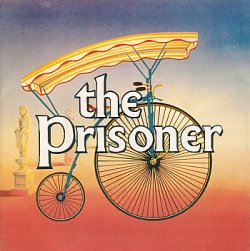
The Prisoner is a 1967 British television series created by Patrick McGoohan, with possible contributions from George Markstein. McGoohan played the lead role as Number Six, an unnamed British intelligence agent who is abducted and imprisoned in a mysterious coastal village. Episode plots have elements of science fiction, allegory, and psychological drama, as well as spy fiction. It was produced by Everyman Films for distribution by Lew Grade's ITC Entertainment.

Portmeirion is a folly tourist village in Gwynedd, North Wales. It was designed and built by Sir Clough Williams-Ellis between 1925 and 1975 in the Baroque style and is now owned by a charitable trust. The village is located in the community of Penrhyndeudraeth, on the estuary of the River Dwyryd, 2 miles (3.2 km) south east of Porthmadog, and 1 mile (1.6 km) from Minffordd railway station. Portmeirion has served as the location for numerous films and television shows, most famously as "The Village" in the 1960s television show The Prisoner.
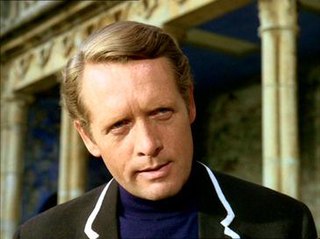
Number Six is the central character in the 1967–1968 television series The Prisoner. The unnamed character in the original TV series was played by series co-creator Patrick McGoohan. For one episode, "Do Not Forsake Me Oh My Darling", Number Six was portrayed by Nigel Stock due to McGoohan being away filming the movie Ice Station Zebra.

Danger Man is a British television series that was broadcast between 1960 and 1962, and again between 1964 and 1968. The series featured Patrick McGoohan as secret agent John Drake. Ralph Smart created the programme and wrote many of the scripts. Danger Man was financed by Lew Grade's ITC Entertainment.
John Drake is a fictional secret agent, played by Patrick McGoohan in the British television series Danger Man. Unlike James Bond, he never carried a gun, rarely used far-fetched gadgets, never got the girl, and rarely killed anyone on screen.

George Markstein was a British journalist and writer of thrillers and teleplays. He was the script editor of the British series The Prisoner for the first thirteen episodes, and appeared briefly in its title sequence. Markstein also wrote for or story-edited other television series, specialising in espionage stories, and jointly ran a successful literary agency for screenwriters.

The Village is the fictional setting of the 1960s UK television series The Prisoner where the main character, Number Six, is held with other former spies and operatives from various countries. The theme of the series is his captors' attempts to find out why Number Six resigned from his job and his attempts to escape from the Village and learn the identity of Number One. Ostensibly, those running the Village – thought by many to be countries around the world – believe that once Number Six is coerced into explaining the motive(s) behind his resignation, all the state secrets he knows will come tumbling out. However, the ultimate use of these secrets is only intimated, but not overtly explored. Beyond its explicit physical setting, the Village is also viewed as an allegory for humanity and society during the Cold War era. Patrick McGoohan notes in various post-show interviews that the Village is "within all of us...we all live in a little Village...Your village may be different from other people's villages but we are all prisoners."

"The Chimes of Big Ben" is an episode of the allegorical British science fiction TV series, The Prisoner. It was written by Vincent Tilsley and directed by Don Chaffey and fifth to be produced. It was the second episode to be broadcast in the UK on ITV on Friday 6 October 1967 and first aired in the United States on CBS on Saturday 8 June 1968.

"Fall Out" is the 17th and final episode of the allegorical British science fiction series The Prisoner. It was written and directed by Patrick McGoohan who also portrayed the incarcerated Number Six. The episode was first broadcast in the UK on ITV on Thursday 1 February 1968 and first aired in the United States on CBS on 21 September 1968.

"The Schizoid Man" is an episode of the allegorical British science fiction TV series, The Prisoner. It was written by Terence Feely, directed by Pat Jackson and was the seventh produced. It was the fifth episode to be broadcast in the UK on ITV on Friday 27 October 1967 and first aired in the United States on CBS on Saturday 6 July 1968.

"Living in Harmony" is an episode of the allegorical British science fiction TV series, The Prisoner. It was written by David Tomblin and Ian L. Rakoff and directed by Tomblin and was the fifteenth produced. It was broadcast in the UK on ITV on Friday 29 December 1967 and was not screened in the United States on CBS during the initial network run.

"Free for All" is an episode of the allegorical British science fiction TV series The Prisoner. It was written and directed by Patrick McGoohan and the second episode to be produced. It was the fourth episode to be broadcast in the UK on ITV on Friday 20 October 1967 and first aired in the United States on CBS on Saturday 29 June 1968.

"The Girl Who Was Death" is an episode of the allegorical British science fiction TV series, The Prisoner. It was written by Terence Feely and directed by David Tomblin and was the sixteenth produced. It was broadcast in the UK on ITV on Thursday 18 January 1968 and aired in the United States on CBS on 7 September 1968.

"Checkmate" is an episode of the allegorical British science fiction TV series, The Prisoner. It was written by Gerald Kelsey and directed by Don Chaffey and third to be produced. It was the ninth episode to be broadcast in the UK on ITV on Friday 24 November 1967 and first aired in the United States on CBS on Saturday 17 August 1968.
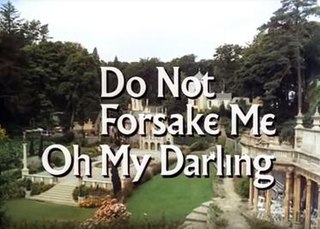
"Do Not Forsake Me Oh My Darling" is an episode of the allegorical British science fiction TV series, The Prisoner. It was written by Vincent Tilsley and directed by Pat Jackson and was the fourteenth produced. It was the thirteenth episode to be broadcast in the UK on ITV on Friday 22 December 1967 and first aired in the United States on CBS on Saturday 3 August 1968.
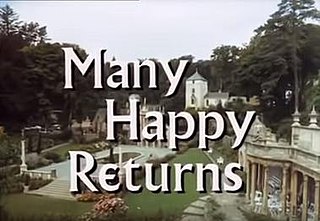
"Many Happy Returns" is an episode of the allegorical British science fiction TV series The Prisoner. It was written by Anthony Skene and directed by Patrick McGoohan. The thirteenth episode produced, it was the seventh episode to be broadcast in the UK on ITV on Friday 10 November 1967, and first aired in the United States on CBS on Saturday 20 July 1968.
The Prisoner, a British television series that originally ran from 1967 to 1968, has been represented in several other media.

The opening and closing sequences of the TV series The Prisoner are considered iconic. The music over the opening and closing credits, as broadcast, was composed by Ron Grainer, a composer whose other credits include the theme music for Doctor Who.
The Prisoner is a 17-episode British television series broadcast in the UK from 29 September 1967 to 1 February 1968. Starring and co-created by Patrick McGoohan, it combined spy fiction with elements of science fiction, allegory, and psychological drama. Since its debut, the series' enduring popularity has led to its influencing and being referenced in a range of other media, such as the film The Truman Show, and the television shows Lost and The X-Files. The producer of The X-Files called The Prisoner "the Gone with the Wind of its genre." The Guardian wrote that "Without The Prisoner, we'd never have had cryptic, mindbending TV series like Twin Peaks or Lost. It's the Citizen Kane of British TV – a programme that changed the landscape."
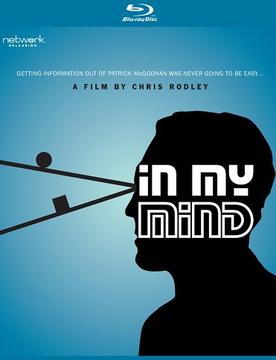
In My Mind is a 2017 British documentary film about Patrick McGoohan and the making of The Prisoner, the late 1960s allegorical science-fiction TV series. The documentary was created and narrated by Chris Rodley for the 50th anniversary of the original airing of the TV series in the UK. The film follows the events surrounding Rodley's visit to interview McGoohan in 1983 for a 1984 documentary about the making of the original series.


















